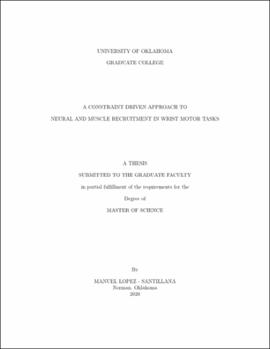| dc.description.abstract | The transformation from visual stimulus to muscle recruitment is a non-
linear one: it must take into account the configuration of the body and the
lines of action of the muscles. The primary cortex plays a role in the mus-
cle recruitment process. Any limb movement can be represented in multiple
coordinate frames; a musculoskeletal representation, where forces are enacted
through muscles, which will be referred to as an intrinsic representation, or by
tracking the resulting visual movement, taking the perspective of a onlooker,
providing an extrinsic representation of the movement. A coordinate system
can also be drawn in respect to the joint orientation. How limb movements are
represented in the primary motor cortex has been an intense focus of research.
Georgopoulos et al. (1982) established that the activity of individual neu-
rons in the primary cortex can be fit to a cosine curve, where the peak rep-
resents an extrinsic direction for which they are maximally activated when
performing limb movements. Due to the association of the neuron’s activity
with an extrinsic direction, Georgopoulos et al. (1982) referred to the peak
activation as the preferred direction (PD), favoring an extrinsic representation
of neural activity. Later on, Kakei et al. (1999) focused on wrist movement and
the corresponding neural activity in a center-out wrist task. Kakei et al. (1999)
observed that the preferred direction of neurons in certain wrist postures: the
supinated, the pronated, and the midrange. Through this observation Kakei
et al. (1999) found that a subgroup of the neurons seem to shift the location
of the preferred direction depending on the wrist posture. In this experiment,
the neurons in the primary motor cortex (MI) region of the brain had their
preferred direction shift less than the actual rotation of the wrist. Oby et al.
(2012) expanded upon this, finding that the corresponding wrist force task
also had PD shifts, with both authors concluding that the resulting PD shifts,
on average, were less than the wrist rotation, with the average MI PD shift
being less than the average wrist force PD.
To model what sort of transformations are possible in the primary motor
cortex, Craig (2013) devised a neural network model as an abstract represen-
tation of this transformation process. Craig’s model is an recurrent neural
network (RNN) that computes the transformation from visual input to forces,
having no assumptions of the transformations that should occur. The model
of Craig seeks to minimize the MSE of the forces produced and regularization,
the activity of the RNN is based upon the minimization of the loss.
In this thesis, I provide an extension of the original neural network model
of force generation in a center-out wrist task that was developed by Craig
(2013). The Craig’s model inputs are the extrinsic representation of the target,
wrist configuration, and task cues. The model is tasked with generating the
corresponding extrinsic wrist force trajectories given those inputs. My model
takes advantage of the Python library of Keras (François, 2015), allowing
for an ease of access to deep learning tools. The model is trained from the
force trajectory of Todorov and Jordan (1998) allowing for a more modern
approach by employing dropout and having a more accurate force depiction.
My model also makes the distinction between target direction and the onset
of forces. The disassociation between these two inputs allows for a better
understanding of the mechanics and transformations that are associated with
each cue. Incorporation of the supinated position into my model permits the
model’s activity to be evaluated in regard to this posture.
In my model, a sub population of neurons consistently exhibit cosine tuning
through various neuron choices and regularization parameters. The sub pop-
ulation was present for all postures, with the supinated posture consistently
containing less stable neurons than the pronated and midrange postures Other
neurons of the model exhibited activity shifts that mainly were time depen-
dent, with little change in activity with respect to target location. The MI
neurons did not exhibit a PD shift across changes in wrist posture. However,
the muscles exhibited a significant difference in PD shift. | en_US |

